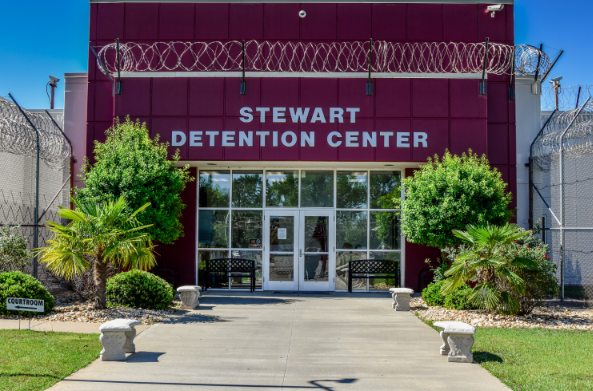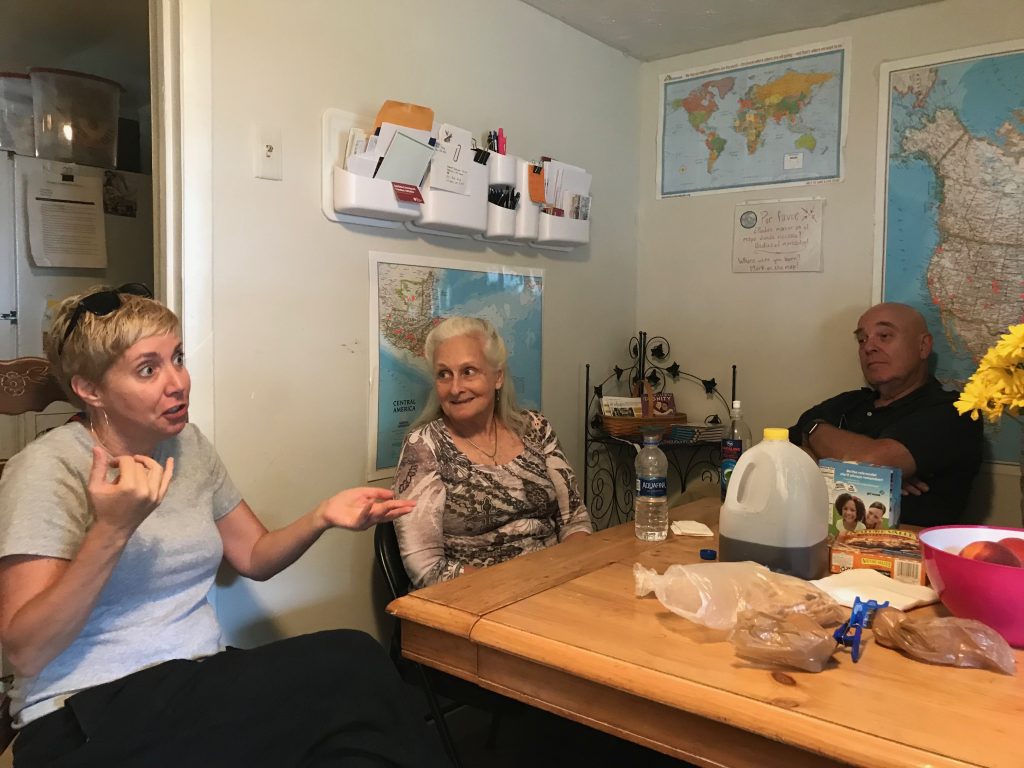
When she reported for work each day at the Stewart County Detention Center, Latifa Craword recalls, “I didn’t know what to expect.”
Hired as a case manager when the facility first opened in October 2006, Crawford was assigned to Level 4 detainees—”drug dealers, rapists, murderers, child molesters, and I didn’t feel safe. My working conditions were too “open” for a detention center.”
Crawford then became a medical assistant, responsible for maintaining medical files of detainees in the byzantine judicial system in the federal Bureau of Immigration and Customs Enforcement (ICE), a division of the Department of Homeland Security. She left her job with CoreCivic, the for-profit prison company headquartered in Nashville, Tennessee that owns and operates the SCDC 33 miles south of Columbus, in 2017 to focus on earning her master’s degree in social work from Troy University-Phenix City. She also works for the Department of Family and Child Services (DFCS) in nearby Sumter County.
In her 11 years at SCDC, she dealt with everything from hunger strikes in the 1,800-inmate facility to tracking down prescriptions for immigrants transferred to SCDC. Interested in the public-health side of social work, Crawford says that after earning her master’s she wants to help, “provide mental-health treatment to help them fight and win their cases.”
“A lot of times, they didn’t get the medication they needed,” Crawford recalls, explaining the difficulty in determining the best medical care for detainees transferred to SCDC by the federal Bureau of Prisons from out of state with no comprehension of English and severe mental illness.
Staff shortages were another issue, she says, with weekend schedules often causing delays in treatment.
“Your condition had to be considered chronic to be referred to the medical staff,” Crawford says. “If you were sick, you had to pass out in order to be seen.”
Cases at SCDC can range from the aforementioned violent felons held as Level 4 detainees—typically arrested in jurisdictions across America and then entered into the ICE legal system due their non-citizen status—to asylum seekers that approach American borders seeking refuge from violence, economic oppression and instability in their native land.
Cases within the ICE system served as a flash point this summer as the Trump administration’s executive order forcing the separation of families stuck in that system sparked intense national debate over immigration—and, by extension, what virtues define core American values:
Is security at the border sacrosanct? Or was this presidential decree just an excuse for rigid, racist policy resulting in “babies in cages” (technically “tender-age facilities,” as ICE calls them)? Do we remain the same United States to which entry is symbolically guarded by the Statue of Liberty and her offer of “Give me your tired, your poor / Your huddled masses yearning to be free / The wretched refuse of your teeming shore”?
Thus, focus is placed on SCDC, normally operating far removed from the spotlight in a dark corner of the American dream in rural southwest Georgia in one of America’s poorest counties, as a symbol of the chaotic immigrant-detention process.
‘TO MAKE IT AS DIFFICULT AS POSSIBLE FOR THE FAMILIES’
Like most Saturday mornings, volunteers sit gathered around the dining room table at El Refugio.
This group of 13 hails from Atlanta and the congregation of Glenn Memorial United Methodist Church, located on the Emory University campus, the school is a liberal bastion in the Deep South where the radical “God Is Dead” theology was taught in the 1960s.
Glenn Memorial is also known to some as a spiritual domain of noted Methodist pastor and musician (and retired professor emeritus at Emory’s Candler School of Theology) Don Saliers, father of Emily Saliers, half of folk-duo legends the Indigo Girls, with whom he co-authored the 2006 book, A Song to Sing, A Life to LIve: Reflections on Music as Spiritual Practice.

A modest yellow house on Main Street on the outskirts of Lumpkin, about a mile from SCDC, El Refugio is “a ministry of hospitality and visitation serving immigrants at Stewart County Detention Center and their families and friends.”
Holly Patrick, a board member of the nonprofit organization, provides an orientation for the Glenn Methodist group, who a week ago were cleared for visitation to SCDC on paperwork submitted by El Refugio. Each volunteer is provided a nine-digit alien number marking the individual detainee they would soon meet. Patrick explains that detainees typically want to talk about their families and their jobs and that they guards can be far from friendly.
El Refugio has rented the house in Lumpkin for about eight years. With a lock-box on the front door, bunk beds throughout and a stash of new luggage at the back door, it has the feel of a boarding house open for those who need it.
A “2018 calendar of racial injustice” by the Equal Justice Initiative hands on the dining room wall. A “hospitality house checklist” hangs on the fridge, as does a “Prayer of Archbishop Romero,” the Catholic leader in El Salvador assassinated in 1980 for his advocacy of liberation theology to lift up the country’s poor by right-wing death squads, the genesis of (now discontinued) annual protests at Ft. Benning against the former School of the Americas (now Western Hemisphere Institute for Security Cooperation, WHINSEC), where they say Romero’s killers were trained for operations funded by the American government.
Earlier this year, Pope Francis canonized Romero as a saint.
Taking a left out of El Refugio, Main Street soon leads south out of Lumpkin city limits down a series of rolling hills consumed by kudzu before a right turn marks the entrance to SCDC and its a massive sea of a parking lot. Arriving at shift change, dozens of employees—all African American and mostly female—are buzzed in to work through metal gates under barbed wire. A smaller, older building—the jail operated by the Georgia Dept. of Corrections on the site until it closed in 2004—withers away next door.
The Glenn Memorial volunteers file into SCDC’s packed waiting room, where they sit for a long delay because of the shift change. Only the pre-approved visitors will be allowed inside and a journalist’s tour request was denied, so from there it’s back toward El Refugio and its next-door neighbor, immigration attorney Martin Rosenbluth.
With his law practice based in Raleigh, North Carolina, Rosenbluth two years ago opted for a more hands-on approach to helping his clients housed at SCDC and purchased the white wood-framed house for $20,000. Seated at a work-messy dining room table, Rosenbluth offers up baked treats he bought in Columbus, where he goes grocery shopping, as his two dogs scamper about the home.
“I think they put the facility here to make it as difficult as possible for the families, friends and attorneys of the detainees,” Rosenbluth says.
Clients report to him tales of emotional abuse from the guards, spoiled food, and either a total lack of medication or substitute meds swapped in for their usual prescription.
“CoreCivic does not provide medical or mental healthcare services or staffing at the Stewart Detention Center,” Rodney King, public affairs manager for CoreCivic, states in response to Rosenbluth’s comments. “The federal government’s ICE Health Service Corps (IHSC) is solely responsible for contracting, staffing and oversight of any medical and mental health services provided at Stewart. CoreCivic staff at Stewart do not make medical or mental health treatment determinations and are trained to refer all detainee health or medical concerns, whether routine or acute, to facility medical staff for evaluation, triage and treatment. IHSC and its contracted service providers make all medical and mental health related decisions, including the timing and nature of outside medical treatment for detainees. Because CoreCivic is not the healthcare provider at this facility, we also do not have access to medical-specific information about detainees. Questions regarding medical or mental health services at Stewart should be directed to ICE officials.”
“Expensive meds cut into CoreCivic’s bottom line,” he says, adding that the corporation also cuts costs with the $1/day inmate labor and by employing a low-wage, unskilled labor pool to serve as guards among its 370 workers. From a legal perspective, Rosenbluth says, “When I tell other immigration attorneys about my cases, they don’t believe me.”
He points to a study conducted by Syracuse University that reveals a six percent success rate for asylum appeals at SCDC, as compared to 45 percent nationwide.
To illustrate, he talks of a client that lost his case for asylum despite fleeing his native Somalia after being forced into fighting for al Shabaab, the Islamic militant group battling that country’s United Nations-backed government. After his client snuck away, al Shabaah tracked him to his native village, where he hid while watching them shoot and kill his grandfather and best friend for protecting his location. The client went on to win his asylum case before the Board of Immigration Appeals, located in Virginia just outside Washington, D.C.
“Everyone has been very nice, very friendly,” Rosenbluth says of his fellow Stewart County residents. “The majority of people here don’t have a clue what goes on at SCDC. Even the majority of the guards don’t.”
Leaving Lumpkin north back to Columbus, a quick chat with Alphonse Thornton confirms this notion. The 20-year-old sat near his parked bicycle in the shade of a veranda over a dusty, shuttered storefront on the town square, a stone’s throw from the stately Stewart County Courthouse, built in 1923 and placed on the National Register of Historic Places in 1980.
“No sir,” Thornton, looking up from his phone, answers in succession to questions asking if he knows anything about SCDC or ever sees activity related to immigrant detainees in his hometown.
Asked if he had an opinion on the subject, Thornton shakes his head no and returns his focus to his phone.
‘AN AMAZING EXPERIENCE’
“It’s very important to the county,” Stewart County Manager Mac Moye says by phone from his office in Lumpkin of SCDC. “It employs 92 Stewart County residents, a plurality of of its workforce of some 370 employees. It’s far and away the largest employer in Stewart County.”
 Moye, whose children reside as seventh-generation Stewart County natives, served as executive director of Historic Westville—the 1850s-era attraction that moved last year from Lumpkin to South Columbus with an opening scheduled for October 20—from 1979 to 2005. He started working at SCDC when it opened in 2006.
Moye, whose children reside as seventh-generation Stewart County natives, served as executive director of Historic Westville—the 1850s-era attraction that moved last year from Lumpkin to South Columbus with an opening scheduled for October 20—from 1979 to 2005. He started working at SCDC when it opened in 2006.
“It was an amazing experience,” recalls Moye. “I got to work with people from all over the world, from every continent. As unit manager, I had the duty of classification, determining the security level of each individual, relative to the danger he poses for himself or others. We strived to make it a safe and secure place for people in detention as they await deportation or a court hearing.”
Because of the wide variety of professionals employed at Stewart, an average salary number might not fully reflect the economic impact of the facility.
King reported that SCDC’s employees combined to earn $15.4 million during 2017, a year in which CoreCivic paid more than 1.3 million in utilities and nearly $450,000 in property taxes.
With the slogan “Enjoy the Bounty in Stewart County,” new businesses include Omaha Brewing Company and Richland Rum. However, the county reached its peak of wealth and population in 1850 as home to large plantations that made it one of the biggest cotton producers in Georgia, with a population of 16,027—46 percent were African-American slaves.
According to the latest U.S. Census counts, Stewart County today has 5,982 residents, 50 percent of which are African American. The per-capita median income is $13,883. Roughly 40 percent of people live below the federal poverty line, defined as $15,063 for an individual and $30,750 for a household of four.
In his book American Gulag: Inside U.S. Immigration Prisons, Mark Dow says that federal agencies choose rural, impoverished areas to build these prisons in partnership with county officials “eager to bring home a recession-prison industry.”
Costs to house prisoners in large cities often exceed $300 per day, Dow states. He figures about three-fourths of system detainees are there from the criminal-justice system, where they’re booked with an A for alien next to name, while 25 percent are there with asylum or visas issues.
Stewart County maintains an Intergovernmental Service Agreement (IGSA) with ICE to detain immigrants on their behalf and maintains a contact with CoreCivic as part of granting the corporatio rights to own and operate SCDC.
According to figures from ICE Southern Region headquarters in Atlanta, the federal government pays Stewart County $65 per day per detainee. Of that sum, Stewart County keeps less than $1, with the rest going to CoreCivic. A quick numbers-crunch shows the Nashville-based for-profit prison corporation nets more than $115,000 a day from SCDC as part of its 1.7 billion in annual revenue that accumulates toward total assets exceeding the $3 billion mark.
The Atlanta Journal-Constitution reported in June that a federal investigation in December described SCDC as “a ticking time bomb” in Dept. of Homeland Security internal documents, with “chronic” problems of drug smuggling, medical staff shortages and safety.
On July 10, SCDC detainee Efrain Romero de la Rosa committed suicide. The 40 year old was a diagnosed schizophrenic and his death came at the end of 21 days in solitary confinement.
It was the third death—and the second suicide by a detainee with diagnosed mental-health issues—in little more than a year at SCDC. According to the Journal of the American Academy of Psychiatry and Law, solitary confinement aggravates suicidal tendencies and the practice should be banned in all prisons.
In April, the Southern Poverty Law Center, a Montgomery-based group originated in the Civil Rights Movement, filed a lawsuit against CoreCivic on behalf of detainees at SCDC claiming that the “Voluntary Work Program” wasn’t voluntary (refusal to work resulted in retaliations from emotional abuse to denied phone privileges) and that the $1/day rate for this forced labor was “a profit-making scheme” by CoreCivic.
In response, three Republican congressmen from Georgia,, U.S. Reps. Buddy Carter, Jody Hice and Barry Loudermilk, sent a letter to Attorney General Jeff Sessions voicing support for $1/day rate for ICE’s Volunteer Work Program. U.S. Rep. Samford Bishop, the long-serving Democrat whose district includes Stewart County, did not offer his support.
Moye declines to discuss the SPLC’s lawsuit other than to say he provided all requested documentation to an attorney during a recent sit-down meeting. He will, however, give his thoughts on protests against SCDC and American immigration policy.
“I don’t have any problem with people coming down here to protest the facility,” Moye says. “They’re doing their patriotic duty to speak out about how they feel on American foreign policy, which is a major issue right now. The very definition of what being an American is the right to contest what your government does. My personal comment about American immigration policy is that it can be criticized,” he continues, “given that we’ve had these wacky laws in place since 1885. That’s what his country has gotten used to but, to me, these laws should be changed.”
Moye refers to the Alien Contract Labor law, enacted in 1885-1887 on the heels of the Chinese Exclusion Act of 1882, and not longer after a U.S. Supreme Court decision in 1875 ruling that immigration policy is the responsibility of the federal government. Critics of this law point to its racist motivations, particularly against Chinese immigrants that came to America to build its railroad system and Sicilians imported here as cheap labor after the emancipation of slaves.
The current crop of racially motivated immigration restrictions targets those hoping to enter the United States from Central and South America, explains Demetri Lopez, a social-work consultant specializing in helping international human-rights organizations send delegations to monitor conflict areas.
“Activism is part of our work,” Lopez, an adjunct professor of social work at Troy University in Phenix City, says of why she and partner Ana Luis Ahern joined other protestors from Indivisible Columbus in Lumpkin on Saturday, June 30, when activists all over the country rallied against Trump’s family-separation decree.
“We went to support El Refugio and because a lot of people in the local area don’t understand what is happening right here in our own backyard. Activism shouldn’t not be limited to posts on Facebook. If you want to help, then go protest. Drop some pizzas on the families of detainees some Saturday night at El Refugio. Sign up to help host them.”
Lopez estimates 75 protestors went to SCDC last month. “They definitely knew we were coming,” she says. “The gates were closed so we had to park on the side of the road. They had buses blocking the entrance so big we couldn’t even see the prison.”
Saying it’s important to be vocal and active in causes you care about, Lopez’s passion for immigration issues comes from her work in countries such as El Salvador, Guatemala and Honduras, where she says the effects of oppressive, self-serving American foreign policy are obvious and ultimately create the conditions that force them to flee. During a fact-finding mission this past October to Guatemala, she learned about women being sexually assaulted or murdered for speaking out against American and Canadian mining corporations’ socially and environmentally exploitative practices.
“These are very specific issues they’re fleeing from are really the results of our influences, historically and today, in Central America,” says Lopez, pointing to Honduras as a place where American support and funding of a corrupt, murderous government in the 1980s created the chaos now consuming it. “I’ve lived and worked in these countries. They can be very scary places but our policymakers have a role in making them scary.”
“I am not interested in going back to work in the prison system,” Latifa Crawford says of her plans post-graduation with her master’s in social-work degree from Troy.
Observing court hearings at SCDC for a class “was an eye-opener for me,” she explains. She described the judges’ use of video-conferencing to preside over cases, with translations from English coming down to detainees through a series of wires and phones, as “unprofessional.”
The four judges at SCDC, like at all other immigrant-detention centers, are not the Article III judges familiar from civil and criminal proceedings with rights and rules spelled out in the U.S. Constitution, such as guaranteed right to counsel. These judges are federal employees of the Department of Justice, led by Attorney General Jeff Sessions, whose decree that fear of gangs or domestic violence was no longer acceptable reason for granting asylum was challenged in federal court last week.
“In most of the cases we observed,” Crawford recalls, “the people had come here as farm workers, been here for years. They asked for voluntary departure because they didn’t have the money to right their case at their own expense. They had kids born and raised here. Who is going to take care of their kids?”
Saying she’s seen less Latinos in the region now that the Tyson chicken-processing plant in Marion County has closed, Crawford describes these immigrant families as living in difficult, and often unseen, situations she observes in her role with DFCS in Sumter County.
“They’re too scared to go out, too scared to call for help if they need it, for fear of being deported,” she says. “They’re stuck between a rock and a hard place. After getting my degree, I want to help them to become U.S. citizens.”


